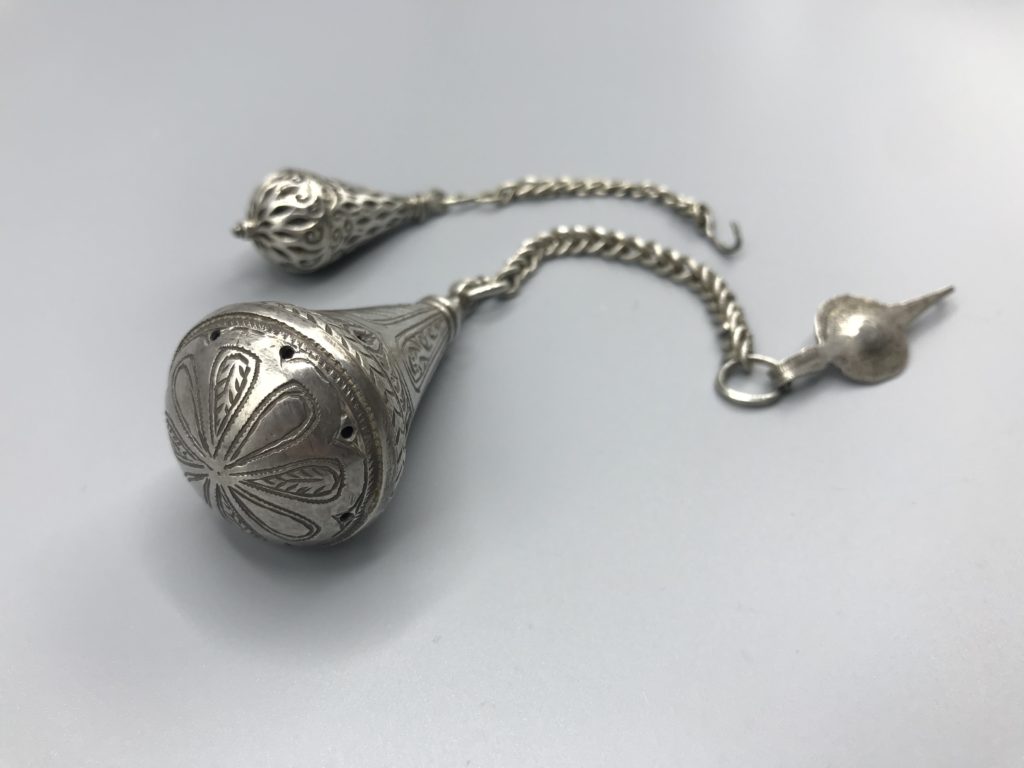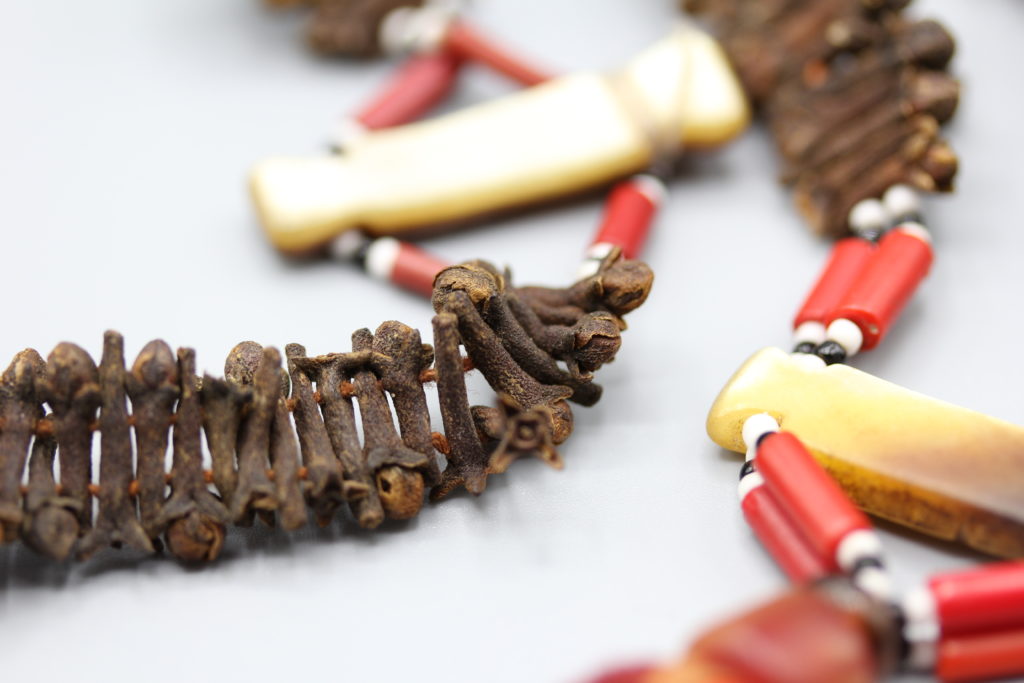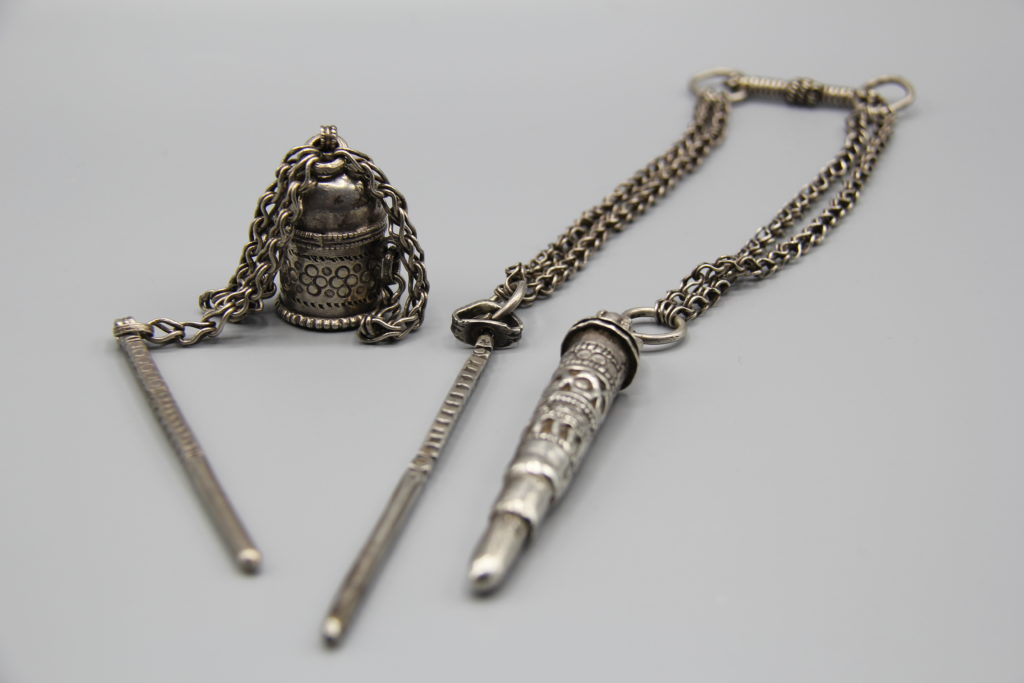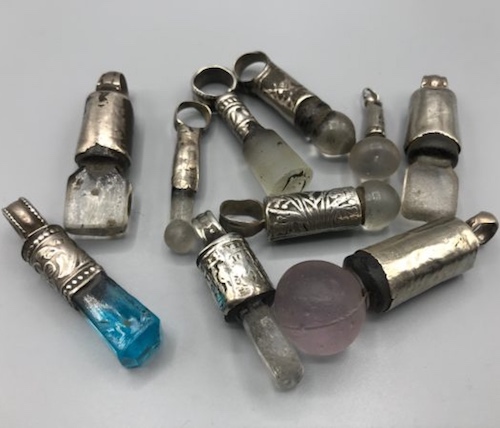Scent is the invisible part of costume and jewellery. It accompanies key transition moments that form
rites de passages in life, from birth festivities to funerary rites, and is also closely related to honour, prestige and hospitality.

Silver containers for ambergris, Morocco
Jewellery with scent
In the western part of the Arab world, jewellery is designed to contain fragrant materials. Morocco is home to elegant containers in the shape of an elongated teardrop or a small circular box. These could be opened to receive a piece of wool or textile that had been soaked into perfumed oil. The containers would dangle at the base of fibulas and with every move of the wearer they would disperse their perfume through small openings.
Clove necklaces are an excellent example of how aromatic substances are worked into marriage traditions. In Palestine and Sinai, necklaces strung of cloves and coloured beads are worn by the bride, her female relatives and her friends on her wedding day. Stringing cloves is easier when they have been softened in water, so the needle can puncture them. The water in which the cloves have soaked is used to wash the bride on the morning of her wedding.

Detail of a clove necklace, Palestine
Perfuming clothing
In the eastern part of the Arab world, most notably on the Arab Peninsula, clothing was perfumed abundantly. Textile is an ideal carrier for scent because its porous structure allows the fragrance to linger for a long time. This, in turn, serves to underline the prestige of the wearer. Just how intense the perfuming of clothing could be, is illustrated by the treatment of the bridal overgarment in the United Arab Emirates. This particular piece of clothing was prepared for the wedding by soaking it for days in scented oils like saffron, jasmine and aloe wood oils, or a mixture of musk and ambergris oils. Rosewater with saffron and musk was also used. After the soaking, the garment was fumigated intensely with musk and ambergris. Imagine how all these scents would mingle with the jingle of bracelets, necklaces and head jewellery!

Silver containers for kohl, Oman
Silver kohl containers
Jewellery and dress form a close, but an outer layer of a person. Underneath that is the body, the carrier of the self. Many natural products were employed as beautifiers, as blessings, as perfume and as health care solution. Body aesthetic carries a variety of values. Together with jewellery and dress, it expressed the identity of a woman. The combined meanings carried by scent, colour, patterns and material wove a beautiful form of protection around the wearer while preparing the mixtures and applying them was both a social and transformative process. Kohl containers form aspects of personal adornment that in some case come very close to jewellery: the kohl containers of Oman and Yemen are true jewels of personal adornment.
Where can I read more?
There are many books about jewellery. A few suggestions to enjoy about the fragrant aspects of jewellery are:
- Paint it, Black by Jolanda Bos: an overview of kohl containers from prehistory to the present
- Aesthetics and Ritual in the United Arab Emirates. The Anthropology of Food and Personal Adornment among Arabian women by S. Kanafani: a beautiful view of personal adornment in the U.A.E.
- Silver and Frankincense, by myself: this book appears in May and introduces the many aspects of scent and perfume in relation to personal adornment
*Feature image: Glass perfume bottle stoppers, set in silver and worn as an amulet, Oman




 Silver containers for ambergris, Morocco
Silver containers for ambergris, Morocco Detail of a clove necklace, Palestine
Detail of a clove necklace, Palestine Silver containers for kohl, Oman
Silver containers for kohl, Oman